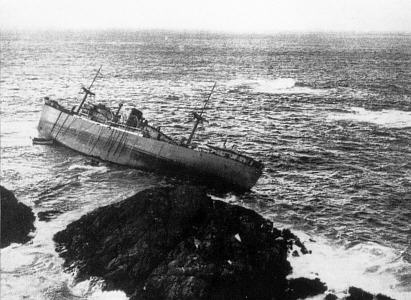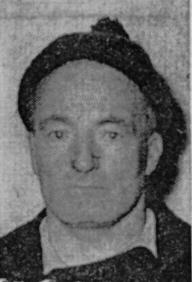The rescue of the Tapti
On the 17th January 1953 - a night of a north-westerly gale and sleet showers - the motor vessel Tapti, of London, ran aground on the Eileen Soa rocks in the Gunna Sound between the islands of Tiree and Coll in the Outer Hebrides. She was a ship of 6,609 tons, bound for Newcastle in ballast with a crew of sixty- two.

The Tapti the day after the rescue
Shortly after quarter to ten she wirelessed for help; but not being sure of her position, reported that she was on Backmor Beg, Treshnish Islands. The coastguard at Duntulm telephoned the Barra Island lifeboat station and the lifeboat Lloyd's left her moorings at 11.00 pm. Then about 11.15 pm the coastguard got in touch with the lifeboat station at Mallaig, and the Mallaig lifeboat, Sir Arthur Rose, launched eight minutes before midnight.
The Mallaig life-boat journeyed over forty-five miles of rough, galeswept sea, in continual showers of sleet, until, about six o'clock next morning, she sighted the Tapti. While she was on passage, the coastguard had given her the Tapti's correct position, through Oban radio; and here she found her, lying with her stern to the shore and listing heavily. H.M.S. Wilton and two trawlers were standing by her, about a mile to seaward. Soon afterwards the Barra Island lifeboat arrived and stood by.

The Mallaig coxswain,
I. Bruce Watt
The Mallaig coxswain took his lifeboat among the rocks which broke up the sea round the wreck, and got to within thirty yards of her, using his lead-line. It was very dark still, and he decided to wait for daylight before trying to take off the crew. Telling the Tapti's captain by morse, he brought out the lifeboat stern first, there not being enough room to turn her. Then he lay off for a couple of hours. The tide was failing all the time, and the Tapti, lifted considerably by the swell, listed to an angle of sixty degrees.
At half light, the coxswain came into action again. He took the lifeboat under the Tapti's port (lee) bow alongside one of the lowered ship's boats, and made fast to a rope hanging from her forecastle. One by one her crew swarmed down the rope - among them several lascars - until all sixty-two were on board the lifeboat. Then the coxswain cast off, and made away from the Tapti again. It had been a strenuous job. The seas, very heavy to seaward of the wreck were breaking up to her bows, and although they were not breaking under their lee, the lifeboat was hampered in manoeuvring by the surge of the swell and the backwash of the rocks only sixty feet to leeward. She had to keep using her engines to stay alongside the Tapti while embarking the crew.
Accompanied by the Barra Island lifeboat, the Mallaig lifeboat made for Tobemory, where she landed the rescued men at 11.30 that night. Altogether she was on service for nineteen hours, the Barra Island lifeboat for twenty-five and a half. The Tapti eventually became a total loss.
The rescue was successfully carried out by fine seamanship and judgement and the R.N.L.I. subsequently made special awards to the Mallaig coxswain, Bruce Watt, and to the seven members of the crew.